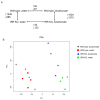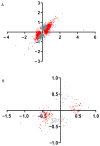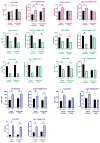A Comparative Kidney Transcriptome Analysis of Bicarbonate-Loaded insrr-Null Mice
- PMID: 38132452
- PMCID: PMC10742211
- DOI: 10.3390/cimb45120606
A Comparative Kidney Transcriptome Analysis of Bicarbonate-Loaded insrr-Null Mice
Abstract
The maintenance of plasma pH is critical for life in all organisms. The kidney plays a critical role in acid-base regulation in vertebrates by controlling the plasma concentration of bicarbonate. The receptor tyrosine kinase IRR (insulin receptor-related receptor) is expressed in renal β-intercalated cells and is involved in alkali sensing due to its ability to autophosphorylate under alkalization of extracellular medium (pH > 7.9). In mice with a knockout of the insrr gene, which encodes for IRR, urinary bicarbonate secretion in response to alkali loading is impaired. The specific regulatory mechanisms in the kidney that are under the control of IRR remain unknown. To address this issue, we analyzed and compared the kidney transcriptomes of wild-type and insrr knockout mice under basal or bicarbonate-loaded conditions. Transcriptomic analyses revealed a differential regulation of a number of genes in the kidney. Using TaqMan real-time PCR, we confirmed different expressions of the slc26a4, rps7, slc5a2, aqp6, plcd1, gapdh, rny3, kcnk5, slc6a6 and atp6v1g3 genes in IRR knockout mice. Also, we found that the expression of the kcnk5 gene is increased in wild-type mice after bicarbonate loading but not in knockout mice. Gene set enrichment analysis between the IRR knockout and wild-type samples identified that insrr knockout causes alterations in expression of genes related mostly to the ATP metabolic and electron transport chain processes.
Keywords: IRR; acid–base balance; alkaline pH; alkalosis; intercalated cells; kidney; receptor tyrosine kinases.
Conflict of interest statement
The authors declare no conflict of interest.
Figures







References
-
- Serova O.V., Gantsova E.A., Deyev I.E., Petrenko A.G. The Value of PH Sensors in Maintaining Homeostasis of the Nervous System. Russ. J. Bioorg. Chem. 2020;46:506–519. doi: 10.1134/S1068162020040196. - DOI
-
- Eladari D., Blanchard A., Leviel F., Paillard M., Stuart-Tilley A.K., Alper S.L., Podevin R.-A. Functional and Molecular Characterization of Luminal and Basolateral Cl−/HCO3− Exchangers of Rat Thick Limbs. Am. J. Physiol. Ren. Physiol. 1998;275:F334–F342. doi: 10.1152/ajprenal.1998.275.3.F334. - DOI - PubMed
Grants and funding
LinkOut - more resources
Full Text Sources
Research Materials

